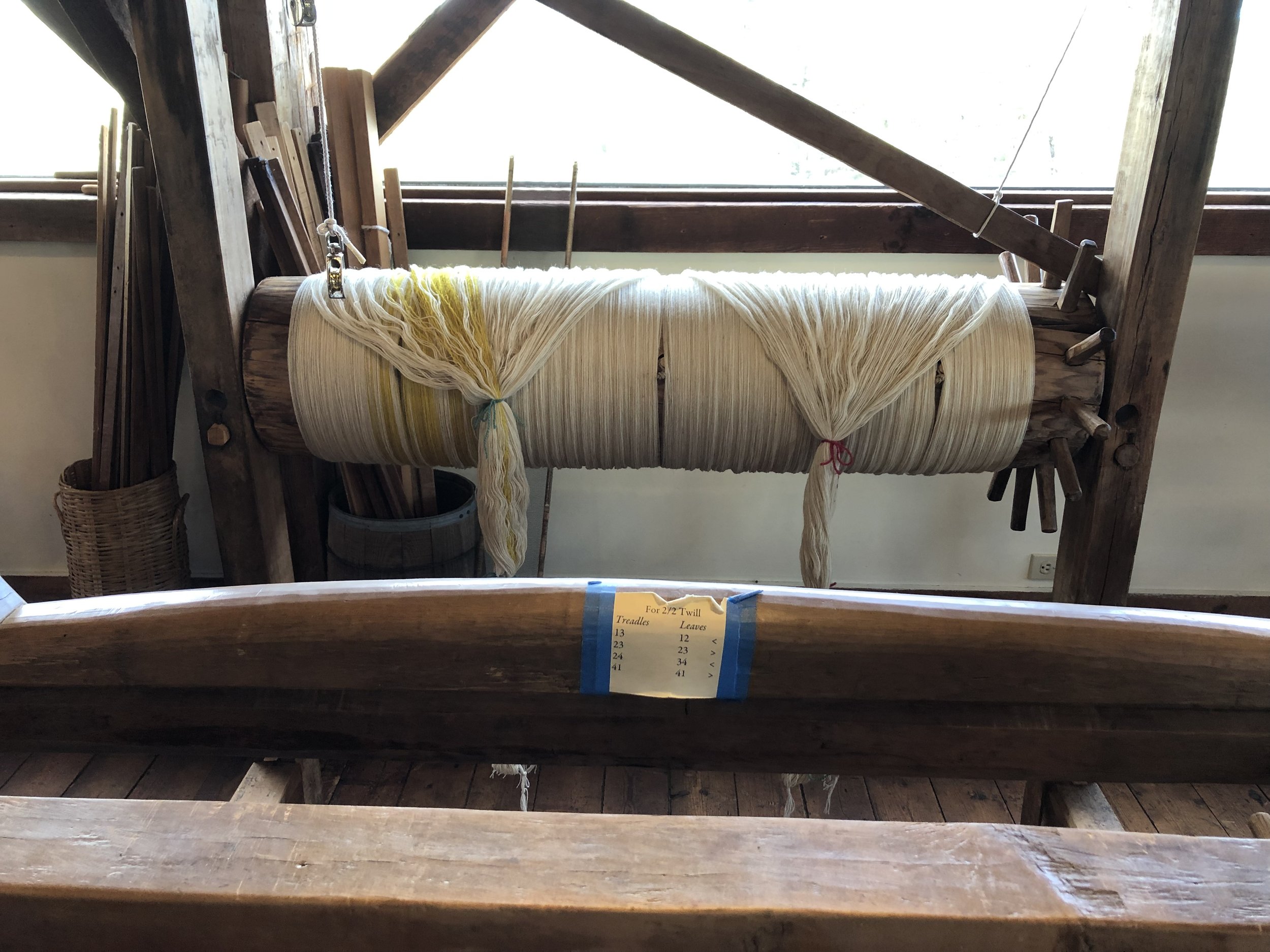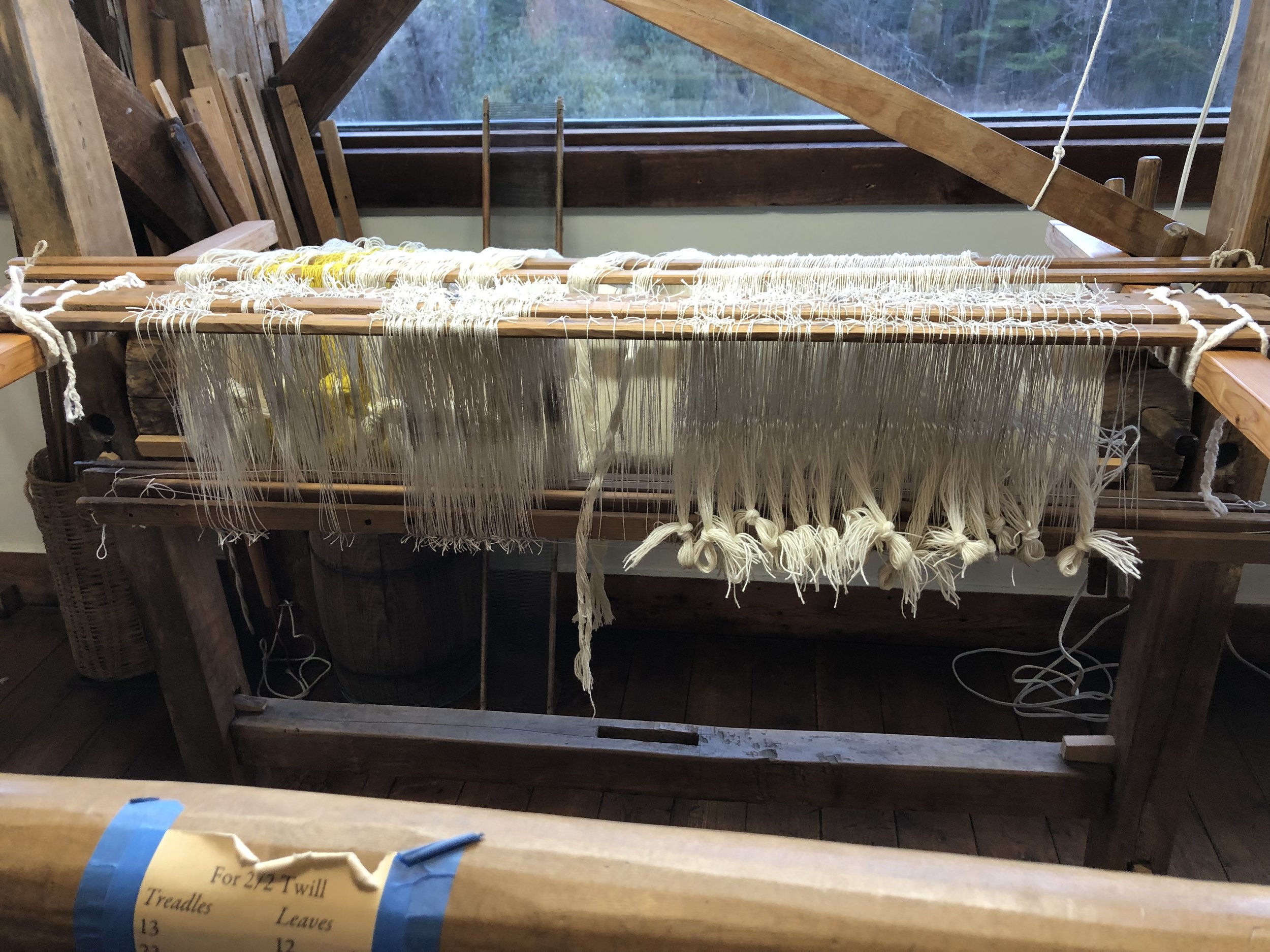Groupie Makes Scottish Wedding Blanket--My trip to Vermont's Marshfield School of Weaving
At the Burrough’s Garret in Newbury, VT
In November my husband (who doubles as my chauffeur) and I crammed our stuff in the car and headed east to Marshfield School of Weaving in Vermont. We drove through the UP, passed my favorite summer swimming place, visited an antique shop near a desolate swamp land (should have bought that fox fur) and made it across the Mackinac Bridge by late afternoon. We stayed the night with chair maker/craftsman Dawson and his family and ate a delicious meal.
View from the Mackinac Bridge in November.
Early next morning we were back on the road. We decided to drive through Canada to Niagra Falls. I wouldn’t choose that way again. It’s very flat…and it was pouring rain and dark when we arrived on the other side very ready for a cocktail, a hot meal and a hotel room. The 4th hotel met our standards after 1—too shady, 2—also suspect, 3—full due to a Christian couples retreat, also we got lost. We ate at Russell’s, a very Italian-American (think Las Vegas) place for a fancy dinner—and met the owner himself! Did I mention the cute busboys in flamenco jackets?
Princess Marcella graces our dinner table.
Next stop—Finger Lakes Region of NY. We were definitely exhausted by this time and me relaying google directions to a grumpy chauffeur was not doing wonders for our marriage. Luckily our friends stoked up their wood fired hot tub—thanks Meg, Jeromy and principessa Marcella—and all our cares melted away. It was a relief to make it to our lodging in Vermont the next day by nightfall—after a giant burrito I slept like a log.
I arrived Monday morning at the weaving school’s barn classroom ready for 5 intense days of learning. The other very friendly students and I began chatting. This was a Foundations Class, so naturally none of them had ever woven before. “You don’t know who Justin is!?” I said in disbelief. Justin Squizzero was the instructor of the course. I had been following him on instagram @burroughsgarret for years, been inspired, asked questions, received advice and even encouragement from him. I learned about weaving techniques from videos he posted of drawing in, throwing the shuttle, measuring the warp, winding the back beam. He shared his process as well as interacted with other weavers and novices like me. I learned a lot just reading the comments passed between him and other textile professionals. In a way I felt he was already my teacher. So they said, “So you’re like a groupie of this guy?”
Justin with his amazing coverlets.
After we students gave our introductions (where I revealed my groupie identity), Justin started the class with history: of himself, of the weaving school and its founders, then—amazingly—of weaving itself, like Stone Age to the present. He effortlessly wove all of this information to create a context that made sense of why we were here—in Vermont, on earth, and as makers of things. Surrounded by looms and equipment hundreds of years old, it was easy to feel a part of the weaving story of humankind.
Justin described the project options and as the most experienced weaver there I was given a nod to take on “the big project”—a Scottish Wedding Blanket—a 7 yard warp with wool singles in 2/2 twill and stripes running down one side as per school founder Norman Kennedy who came to the US from Scotland via Pete Seeger in the 60’s. The wool came from Vermont sheep and was spun at Green Mountain Spinnery where the school has a relationship and orders yarn for specific projects.
After lunch we observed multi-strand warping—something I had seen Justin do before and the major reason I was taking the class. After all it was quite simple, but needed the right set-up: a skarne otherwise known as a spool rack leaned up against a chair with a rock to hold it in place was how it all worked. In a few hours I had warped up 44 inches of cloth width, 9 strands at a time. To those who don’t weave, just imagine measuring 7 yards each of 792 strands, one strand at a time, then divide that time by nine—so much time saved!
Justin sets up for multi-strand warping.
The skarne that makes it all possible.
Tuesday my warp was wound on the back beam and the rest of the day was spent threading the heddles (each thread goes through a heddle that enables it to lift or lower to create the weave). I used the technique I learned from Justin to efficiently draw in multiple threads by organizing them in larger groups in my left hand first—too hard to explain here—take the class to find out!
My beautifully wound warp—Look Mom, no paper!
Halfway threading!
Threading heddles—almost done—notice it’s dark outside!
Wednesday it snowed the first snow. I sleyed the reed, learned about winding pirns, throwing end feed shuttles and wove my first yard of blanket cloth.
Sleying the reed.
The first few inches of picks.
End feed shuttles from England with metal tips for using as fly shuttles—I had never used these before. Winding the pirns was a challenge.
Thursday I came in early to get to weaving. Later on Justin said, “No pressure, but we’ll be having a waulking event with Norman tomorrow, so you’ll want to aim to be done around noon before the event.” Yikes! So the rest of the day was me leaning over the loom throwing the shuttle into the evening. Thank heavens my pirn boy aka Jarrod wound pirn after pirn for me. As soon as he wound one, I had woven one off. I couldn’t have finished the blanket in good time without him.
Friday I manically finished weaving the last of the 6.5 yards by 1pm and spent not enough time fixing mistakes, snipping end threads, and sewing the blanket beginning to end to make a loop for waulking. The blanket went to soak in the sink with dish soap to get some of the spinning oils out and get it ready.
Weaving the Scottish Wedding Blanket.
Teacher looks on at the end of the day.
The blanket soaks before waulking.
Meanwhile we had a meaningful and celebratory “commencement” with Tom Cat Gin in cute little glasses. Justin told a tear jerker (my paraphrase here doesn’t do it justice) about us humans actually being a part of the object’s life rather than the other way around. These objects (looms, blankets, human made things) last beyond the maker’s lifetime. They pass from hand to hand and we are simply one part of their story from their origin to their future existence.
Then founder, weaver, folk singer, and Marshfield School celebrity Norman Kennedy arrived as did some students from a previous class, Andrea (my flax linen teacher!) who was teaching a warp weighted loom class and her students. Cookies were shared. I was told to sit at Norman’s left side—nearest the heart—at a place of honor since it was my blanket. He said my color choice for the stripes was cute! The singing and rhythmic pounding began. Every now and then Norman would check the width to see if we were done yet.
Waulking is a way of fulling the blanket—you sit in a circle with the damp blanket on the table and basically group felt the blanket. The threads bind together to make the blanket stronger and warmer. The singing helps keep everyone together and entertained (some of the lyrics are pretty bawdy). Another blanket was waulked after mine and then it was time to go.
Justin Squizzero sings Springfield Mountain while waulking my freshly handwoven Scottish Wedding Blanket at Marshfield School of Weaving.
Norman sang several songs and the blanket shrank.
Norman wraps my blanket on a board to dry flat. He finished it with a blessing in Gaelic.
It was a whirlwind week full of activity and I am still digesting it all after more than a month. My goals for the class were: to find out if I was on the right track with my technique—having been a book taught weaver, to experience old looms and antique weaving tools, to learn efficient production based techniques, to learn the history of handweaving in America, and to meet my weaving idol ;) While there I was able to browse antique textiles, meet fellow weavers, make friendships, soak up Justin’s knowledge of all things weaving, weave my widest warp yet, pick up the subtle movements and small details that make the weaving process graceful. I was grateful to meet Kate, Dosia, and my classmates and to share this time with them.
From Kate’s antique textile collection. Those coverlets!
More pattern inspiration from Kate’s collection.
My favorite things in Vermont: handwoven wool blankets, antique linens in cupboards, sourdough rye bread, wood stove heat, Tom Cat Gin, Justin’s coverlets, Marshfield School of Weaving, Montpelier’s Co-op, Roxbury Russet apples, and Justin—his excellent teaching skills, encouragement, humour, willingness to share his knowledge and skills, as well as charm, lovely singing voice, and good taste in milk paint. I highly recommend taking a class here.
The blanket drip drying on a board.
We avoided the huge snow storm in Buffalo on our way back by going south. Vermont was charming as can be, not so much Ohio. We came back and harvested our willow patch. And more than a month later I finally finished rewashing and drying the blanket, cutting it and hand sewing the two halves together. I’m proud of my blanket—and who knows who it will be keeping warm a hundred years from now.
Many thanks to the Marshfield School of Weaving scholarship fund and the Chequamegon Bay Arts Council artistic grant for supporting this opportunity for my development as a craftswoman.
Jarrod investigates the fly shuttle mechanics on Justin’s loom.























